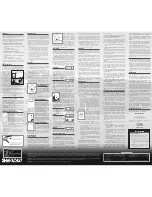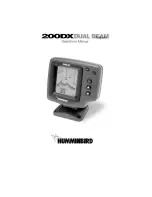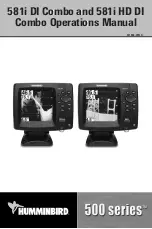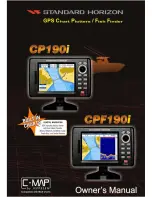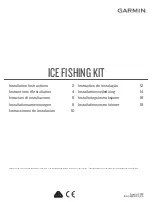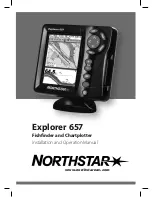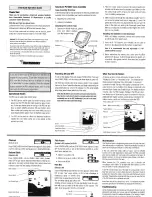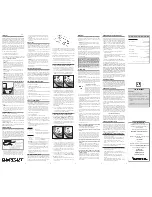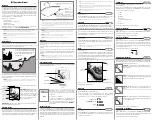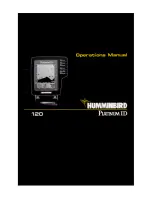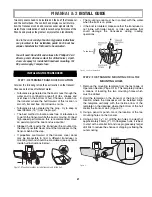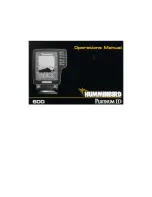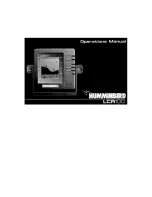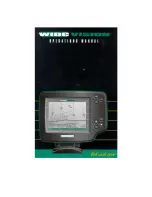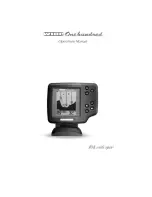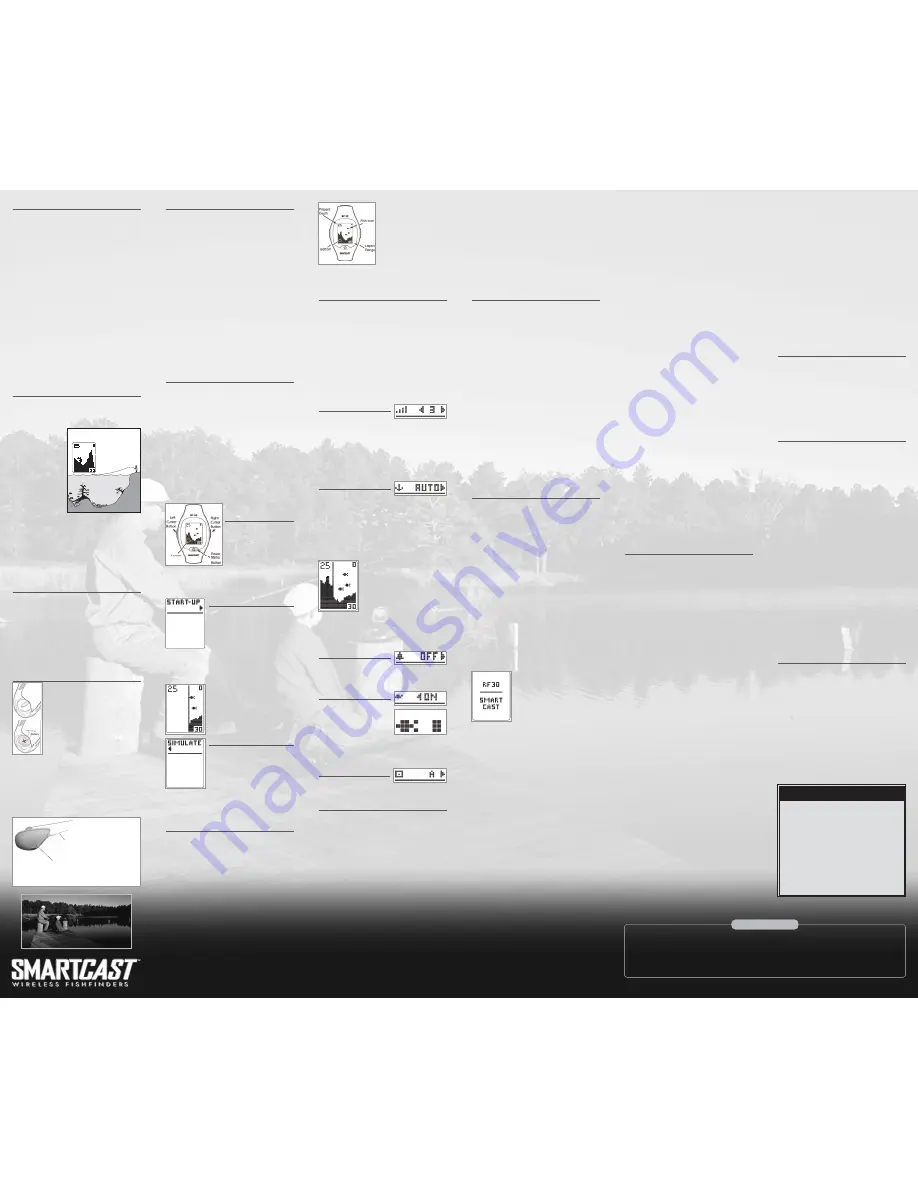
Thank You!
Thank you for purchasing an RF30 SmartCast wireless
fishfinder from Humminbird, America’s #1 Manufacturer of
quality consumer marine electronics.
The RF30 SmartCast Wrist Sonar product comes in two
models, the RF30 Wrist Mount, which has one RSS, and the
RF30 SmartPack, which has two RSS units.
For the RF30 Wrist Mount model, you should have:
• One Remote Sonar Sensor - RSS(TM) - Channel A
• One SmartCast Wrist Sonar with installed 2450CR
battery
• One extra 2450CR battery
• SmartCast Wrist Sonar Operations Manual.
For the RF30 SmartPack model, you should have:
• Two Remote Sonar Sensors - RSS(TM) - Both Channel
A
• One SmartCast Wrist Sonar with installed 2450CR
battery
• One extra 2450CR battery
• RF30 SmartCast Wrist Sonar Operations Manual.
If any of these components are missing or are not included,
please contact our Customer Resource Center at 1-334-
687-0503.
Using the SmartCast
The SmartCast is a first-of-its-kind wireless fishfinder that
is incredibly easy to use. Simply attach the Remote Sonar
Sensor (RSS) to the end of your fishing line and cast it into
the water as you would a normal float or lure. Then power
on the SmartCast Wrist
Sonar and you are
ready to fish. The
SmartCast system uses
sonar technology to
send sound waves from
the RSS into the water.
The returned “echoes”
are transmitted with
wireless technology to
the Wrist Sonar and
plotted on the LCD.
New information appears on the right. As this information
moves to the left a very accurate picture of the underwater
world is created, including the display of underwater objects
such as the bottom, fish, and structures, as well as the
depth of the bottom.
NOTE:
The RF30 LCD is designed to be used with polarized
sun-glasses only when the user is looking straight at the
screen. You may not be able to read the LCD from other
angles when wearing polarized sunglasses.
Operational Modes
The RSS can be used in two distinct ways:
Sonar Graph:
The RSS can be used to create a sonar graph
of the bottom. Cast the RSS into the water beyond an area
of interest. Retrieving the RSS slowly and steadily will
produce a screen detailing structure, fish and bottom detail.
Rhythmic wave action and rocking may cause the display of
a rippled bottom.
Stationary Float:
The RSS can be used as a float in a
stationary location to monitor the area below, giving you a
live update as fish approach your bait.
Activating the Wrist Sonar Battery
When you first use the RF30 SmartCast
Wrist Sonar you will need to activate the
display battery. Use a coin to remove the
battery door on the back of the Wrist Sonar,
then remove the plastic strip located in the
battery compartment. Make sure that the O-
ring in the battery compartment is present,
positioned correctly in the grooves, and free
of debris before re-installing the battery door
to assure water resistance.
NOTE:
Replace the Wrist Sonar battery only with a 2450 CR-
type battery. These batteries can be purchased from most
electronics retailers.
NOTE:
Under normal use you should expect the life of the
display battery to last from 25 to 30 hours of operation.
Operation in cold weather will significantly reduce the life of
the battery.
Attaching the RSS
The line coming from your reel can be tied off to the front
hole in the green Remote Sonar Sensor (RSS). If you wish to
also use the RSS as a conventional float, use the second
hole to attach your hook using a lighter weight line. A snag
will break the lighter line if you have to break free. Slip line
techniques are not recommended because of the higher
risk factor for loss of the RSS. If you do use the slip line
method use a lighter weight line after the lower stop,
enabling retrieval of the RSS if the lower line with hook
breaks away.
CAUTION: You will increase the possibility of breaking your
line if you use light test pound line on your reel. The RSS is
positively buoyant (is buoyant under its own weight plus .2
ounces of bait and lead weight.) The maximum amount of
weight for any attachment to the RSS is approximately
¹²₆₄
to
¹³₆₄
ounces, and includes the combined weight of any
hook, line, weight, swivel/snap swivel and bait that is
attached to the RSS. The RSS itself weighs 1 ounce, and
therefore light test line might break.
Store the RSS in a dry, non-metallic container, such as a
tackle box, in a separate compartment, and isolated from any
metallic devices.
RSS Power
The Remote Sonar Sensor (RSS) has a separate, non-
replaceable lithium battery that has a shelf life of three
years and will last for approximately 400 hours of in-water
use. Discard the used RSS in compliance with local laws as
you would any electronic component or battery.
The RSS has contacts that perceive when the device is
immersed in the water. These contacts turn on the Sonar
Transmitter/Receiver and begin transmitting the sonar
information via RF to the display. The RSS automatically
stops using power a few seconds after being pulled out of
the water.
NOTE:
Store the RSS in a dry area when not in use to
conserve power. Never place the RSS in a wet area of a boat
or on a metal surface that could accidentally power it on.
Also, if the RSS was used in salt water, rinse it with fresh
water before final storage.
Powering the Wrist Sonar
Display ON and OFF
To turn on the display, press and
hold POWER-MENU until you
hear the beep, then release.
Press and hold POWER-MENU
until the display unit shuts down
to power off.
CAUTION!
The Wrist Sonar display DOES NOT have an
automatic shut off function. It will continue to draw current
unless it is manually shut down by pressing and holding the
POWER-MENU button.
Startup in Fishing Mode
After pushing the POWER-MENU button
to turn on the Wrist Sonar, you will see
the Start-up screen. The Start-up screen
will disappear automatically after two
seconds have passed, without further
action from you. In Fishing mode, the
screen will either display sonar information or the RF30
SmartCast screen will appear, indicating that no sonar
information is currently available (See Troubleshooting for
more information about the RF30 SmartCast screen).
When you have powered on the Wrist
Sonar and have cast the RSS into the
water, returned sonar data will start to
be displayed on the LCD. A vertical line
will appear first, followed by a bottom
depiction and possible fish locations if
fish are sensed.
Startup in Simulator Mode
After pushing the POWER-MENU button
to turn on the Wrist Sonar, and the
Start-up screen is displayed, quickly
press the Right Cursor Button to enter
Simulator mode. Once you are in
Simulator mode, the screen will show
Simulate, and after two seconds, the screen will start to
display simulated data. To exit Simulator mode, you must
power down the Wrist Sonar.
Understanding the
On-Screen Images
The SmartCast displays received underwater sonar
information in an easy to understand format. The top of the
display corresponds to the water surface, and the bottom of
the display corresponds to the selected Depth Range (see
Depth Range). The display varies as the area under the RSS
changes. Reeling in the RSS at a slow and steady rate will
allow you to graph the bottom for structure, detail and fish.
Digital readouts provide precise information for bottom
contour, depth and fish locations below the RSS.
If you are using SmartCast to
graph an area, terrain and
bottom composition variations
are displayed on-screen. Fish
and bait fish are displayed
when detected. Underwater
conditions vary greatly, so some
experience and interpretation is
needed to realize all the
benefits of the SmartCast – use the picture above as a
guide to the most common conditions and practice using
the SmartCast over known bottom types.
Menu Features
A simple menu system accesses the adjustable features of
the SmartCast Wrist Sonar display. To activate the menu
system, press the POWER-MENU button; the first time you
do this after power up, the Sensitivity menu will appear.
Once the Wrist Sonar has been powered on, pressing the
POWER-MENU button will display the last menu viewed.
Press POWER-MENU repeatedly to access other SmartCast
menu choices, one at a time. When a menu choice is on the
display, use the RIGHT and LEFT Cursor buttons to adjust
the menu settings. Menus are automatically removed from
the screen after several seconds.
NOTE:
Menu settings are not saved in memory. All settings
return to factory defaults when the SmartCast is turned off.
Sensitivity
Press POWER-MENU until the
Sensitivity menu appears. Select a higher number to show
smaller sonar returns on-screen, or a lower number to
remove clutter from the screen. Adjusting Sensitivity also
affects how sonar returns not attached to the bottom are
identified as Fish ID Symbols. Larger returns will be shown
as fish at a lower setting. Increasing Sensitivity selects
smaller returns to be identified as fish. Sensitivity settings
range from 1 to 5. Default = 3.
Depth Range
Press POWER-MENU until the
Depth Range menu appears. Select AUTO to have the
SmartCast automatically set the Depth Range. Select
10,15, 20, 30, 60 or 100ft. to set a manual depth range.
This locks the depth range to a specific setting. Default =
AUTO.
NOTE:
In manual operation, if the water depth is greater than
the depth range setting, the bottom will not be visible on-
screen. Select AUTO to return to automatic operation.
Depth Scale changes or signal loss will
cause lines with missing detail and/or
abrupt changes in the graphed bottom.
When the Depth range is set to AUTO,
the depth is set to keep the bottom in
the lower third of the screen. The
screen image jump shown here is due
to an automatic change in depth. New returns graphed at a
different scale will not match up with the historic data
already graphed at a higher or lower scale. Vertical lines can
also occur as the radio signal from the RSS is lost and then
regained in rough water conditions.
Fish Alarm
Press POWER-MENU until the
FISH ALARM menu appears. Select OFF for no fish alarm, or
ON for fish alarm. Fish ID must be set to ON for Fish Alarm
to work. Default = OFF
Fish ID
Press POWER-MENU until the
FISH ID menu appears. Select
either OFF to view “raw” sonar
returns, or ON to take advantage
of SmartCast’s ability to identify
sonar returns that are determined to be fish. The sensitivity
setting also affects the definition of sonar returns as fish
(see Sensitivity). Fish Alarm does not sound if Fish ID is
turned off. Default = ON
Channel
Press POWER-MENU until the
CHANNEL menu appears. Select either A or B to match your
RSS. See Channel A and B RSS Units. Default = Channel A
Channel A and B RSS Units
There are two versions of the RSS that are available at your
local tackle dealer, major outdoor retailers, or at
www.humminbird.com
: Channel A and Channel B.
The Channel A RSS unit comes standard with the RF30
Wrist Mount and SmartPack SmartCast products. You also
have the option to purchase additional Channel A or
Channel B RSS. When using the A or B version of the RSS,
make sure to select the appropriate channel in the Channel
menu of your Wrist Sonar display.
The A & B Channel Option is intended to give you the
flexibility to change to a different channel if another angler
is using a SmartCast product within 100 feet of your display.
Two Channel A or two Channel B RSS units in the water
within 100 feet of the display will cause RF interference that
prevents the product from functioning properly, resulting in
fluctuating depth readings and excessive clutter on the
screen. If you use a Channel B RSS while another angler is
using an Channel A RSS or vice versa, the interference will
be reduced but not completely eliminated.
NOTE:
RSS units, regardless of Channel, either in close
proximity to each other or to other sonar devices (closer than
40 feet) can also experience or cause sonar interference,
which may result in erratic depth readings.
Maintenance
Your SmartCast is designed to provide years of trouble-free
operation with virtually no maintenance. Follow these simple
procedures to ensure your SmartCast continues to deliver
top performance.
After using the RSS in salt water, wipe the affected surfaces
with a cloth dampened with fresh water. The RSS Wet
Switch
TM
pins must be rinsed with fresh water after
exposure to salt water to prevent corrosion.
If the Wrist Sonar comes into contact with salt spray, wipe
the affected surfaces with a cloth dampened with fresh
water. When cleaning the LCD protective lens, use a
chamois and non-abrasive, mild cleaner. Do not wipe while
dirt or grease is on the lens. Be careful to avoid scratching
the lens. Do not use a chemical glass cleaner on the lens,
as this may cause it to crack.
If your RSS remains out of the water for a long period of
time, it may take some time to wet it when returned to the
water. Small air bubbles can cling to the surface of the RSS
and interfere with proper operation. These bubbles dissipate
with time, or you can wipe the face of the RSS with a wet
cloth.
Never leave the RF30 SmartCast product in a closed car or
trunk - the extremely high temperatures generated in hot
weather can damage the electronics.
Troubleshooting
Do not attempt to repair the RF30 Wrist Sonar or RSS
yourself. There are no user serviceable parts inside, and
special tools and techniques are required for assembly to
ensure the waterproof integrity of the housings. Repairs
should be performed only by authorized Humminbird
technicians.
Many requests for repair received by Humminbird involve
units that do not actually need repair. These units are
returned “no problem found.” If you have a problem with
your SmartCast, use the following troubleshooting guide
before calling the Customer Resource Center or sending
your unit in for repair.
NOTE:
Retrieving the RSS too rapidly, or the repetitive rocking
motion of rough water, can result in loss or distortion of the
bottom picture. This will cause intermittent screen display. For
best bottom detail, perform a smooth and slow reel-in with
constant speed and the rod tip up (holding the rod tip low or
using a heavy line may cause the RSS to submerge and
momentarily lose radio contact). The RSS has a maximum
transmit range of 75 feet. If the unit is cast or drifts more than
75 feet away from the receiver, the signal may be inconsistent
or lost.
1. The SmartCast loses signal.
If you are not able to get an RF signal
from the RSS, the display will stop
updating (the screen will freeze) and the
RF30 SmartCast screen will be
displayed. Whenever reception is lost or
the RSS emerges from the water for
more than a few seconds, the RF30
SmartCast screen will be displayed until the RSS is placed
back in the water and reception is regained.
• The Smartcast system is a line-of-sight wireless
product. If objects are placed between the RSS and
the Wrist Sonar, including your own wrist, the
reception may be lost.
• The RF30 depth range is 2 to 100 feet (.6 to 30
meters). Erratic readings may occur in water that is
shallower than 2 feet. In addition, because of the
nature of sonar, this product is not intended for use in
swimming pools or small enclosed bodies of water.
• Reeling the RSS too fast can cause loss of signal and
the screen will freeze
• Check the buoyant balance between the RSS and your
tackle; over .2 ounce will submerge the RSS, causing
signal loss.
2. Nothing happens when I turn the Wrist Sonar on.
Check the battery position and make sure that the battery
door is properly closed. Also, make sure that you have
removed the plastic strip that is located in the battery
compartment when it is new.
If this doesn’t help, replace the battery. After replacing the
battery, if the unit still doesn’t power up, remove the battery
door again and re-install.
3. When in very shallow water, I get gaps in the bottom
reading and inconsistent digital depth indication.
The SmartCast will work reliably in water 2’ (.6 m) or
deeper. The depth is measured from the RSS. A transmitter
(RSS) to receiver (Wrist Sonar) distance of greater than 75'
may cause intermittent screen display. Overly rough water
may cause the RSS to submerge, again losing contact.
Be sure to include the RSS if returning the unit for
repair.
4. The screen begins to fade out. Images are not as sharp as
normal.
Check the battery position and make sure that the battery
door is properly closed. Also, make sure that you have
removed the plastic strip that is located in the battery
compartment when it is new.
If this doesn’t help, replace the battery. After replacing the
battery, if the unit still doesn’t power up, remove the battery
door again and re-install.
5. The display shows many black dots at high sensitivity
settings.
You are seeing noise or interference caused by one of
several sources. Noise can be caused by other electronic
devices. Turn off any nearby electronics and see if the
problem goes away. Other sonar devices or any electronic
device operating in the 900 mHz range could cause
interference with your SmartCast.
6. The display shows fluctuating depth readings and
excessive clutter, including vertical bars that may be drawn
on top of fish icons.
The SmartCast system comes with the capability to receive
separate signals from Channel A RSS or a Channel B RSS.
Two A- or B-type RSS units used simultaneously, as well as
one A- and one B-type RSS unit used simultaneously, can
cause RF interference between each other.
7. The screen jumps and the bottom has an abrupt change;
sometimes a vertical line is missing or a black line from top
to bottom is displayed.
This screen image jump is due to an automatic change in
depth. New returns graphed at a different scale will not
match up with the historic data already graphed at a higher
or lower scale. Vertical lines can also occur as the radio
signal from the RSS is lost and then regained in rough water
conditions.
Techsonic Industries 6 Month Limited Warranty
We warrant to the original retail purchaser that Techsonic
Industries products have been manufactured free from
defects in materials and workmanship. This warranty is
effective for six months from the date of original retail
purchase, excepting that where Techsonic Industries
products are used commercially or in any rental or other
income producing activity; then this warranty is limited to
ninety days from the date of original purchase for
mechanical and electrical products.
We will provide replacement product without charge for any
Techsonic Industries product not covered by this warranty,
which is returned (freight prepaid) within the warranty
period to the dealer from whom such products were
purchased, or to us at the appropriate address. In any such
case, Techsonic Industries products found to be defective
and covered by this warranty will be replaced or repaired at
Techsonic Industries’ option, and returned to the customer.
Techsonic Industries’ sole responsibility under this warranty
is limited to the repair or replacement of product which is,
in Techsonic Industries’ opinion, defective. Techsonic
Industries is not responsible for charges connected with the
removal of such product or reinstallation of replacement or
repaired parts.
We will have no obligations under this warranty for any
product which has been:
• improperly installed;
• used in an installation other than as recommended in
our installation or operation instructions or
specifications;
• damaged or has failed due to an accident or abnormal
operation including racing, misuse or alterations
outside our factory;
• repaired or modified by entities other than Techsonic
Industries;
• used on an engine/boat combination where the
engine horsepower exceeds the rating established by
the boat manufacturer;
• used with other product(s) which, in Techsonic
Industries opinion, are incompatible with the
Techsonic Industries product.
THIS WARRANTY IS EXPRESSLY IN LIEU OF ANY OTHER
WARRANTIES, OBLIGATIONS OR LIABILITIES ON THE PART
OF Techsonic Industries AND WILL BE THE CUSTOMER’S
EXCLUSIVE REMEDY EXCEPT FOR ANY APPLICABLE
IMPLIED WARRANTIES UNDER STATE LAW WHICH ARE
HEREBY LIMITED IN DURATION TO six months FROM THE
DATE OF ORIGINAL PURCHASE. IN NO EVENT WILL
Techsonic Industries BE LIABLE FOR ANY INCIDENTAL OR
CONSEQUENTIAL DAMAGES FOR BREACH OF ANY
EXPRESS OR IMPLIED WARRANTY RELATING TO THE
PRODUCTS.
Some states do not allow limitations on an implied warranty,
or the exclusion of incidental or consequential damages, so
the above exclusions may not apply to you. You may also
have other rights which vary from state to state.
You must contact our Customer Resource Center to receive
a repair authorization number before sending your
SmartCast RSS or Wrist Sonar to our factory for service.
This authorization number should be included on the
shipping label when returned to our factory. In addition, a
letter describing the problem you are experiencing, along
with your name, address and daytime telephone number
must be included, so that we can contact you about your
repair if necessary.
International Purchases
A separate warranty is provided by international distributors
for units purchased outside the United States. This warranty
is included by your local distributor and this distributor
maintains local service for your unit. Warranties are only
valid in the area of intended distribution. Units purchased in
the United States or Canada must be returned to our factory
in the United States for service. This product is approved for
use only in the United States, Canada and Australia . Use in
any other country may violate local communi-cations
regulations.
SERVICE POLICY
This Service Policy is valid in the United States only. This
applies to Humminbird units returned to our factory in
Eufaula, Alabama, and is subject to change without notice.
All repair work is performed by factory-trained technicians
to meet exacting factory specifications. Factory serviced
units go through the same rigorous testing and quality
control inspection as new production units.
Even though you’ll probably never need to take advantage
of our incredible service guarantee, it’s good to know that
we back our units this well. We do it because you deserve
the best. We will make every effort to repair your unit within
three working days from the receipt of your unit. This does
not include shipping time to and from our factory. Units
received on Friday are usually shipped by Wednesday, units
received Monday are usually shipped by Thursday, etc.
We reserve the right to deem any product unserviceable
when replacement parts are no longer reasonably available
or impossible to obtain.
After the original warranty period, a standard flat rate
service charge will be assessed for each repair (physical
damage and missing parts are not included). Please call our
Customer Resource Center to verify the service charge for
your unit.
If charges are not prepaid, the unit will be returned C.O.D.
If you are experiencing problems related to bottom or depth
readings, please send your RSS (Remote Sonar Sensor)
along with your Wrist Sonar when sending for repair.
Customer Resource Center
If you have any questions or would like to order replacement
RSS units, visit Product Support on the Web at:
www.humminbird.com
or call our Humminbird
Customer Resource Center Hotline:
1-334-687-0503
Throughout the U.S. and Canada, hours are Monday-Friday,
8:00 a.m. to 4:30 p.m. Central time.
Humminbird
Service Department
108 Maple Lane
Eufaula, AL 36027
WARNING!
The RSS (Remote Sonar Sensor) is not intended for use by children younger than 6 years old without adult supervision as the RSS may represent a choking hazard to small children. The electronic parts in the Remote Sonar Sensor (RSS)
are made to withstand use when casting into water. Because shock from abrupt contact with rocks can damage your RSS we recommend using this sensor in water 1 foot and deeper. Do not place the RSS in a wet area when not in use as this
will turn on the RSS and shorten its usable life. The bottom of the RSS should not be handled during sonar operation. This product is approved for use only in the United States, Canada and Australia. Use in any other country may violate local
communications regulations.
WARNING!
Disassembly and repair of this electronic unit should only be performed by authorized service personnel. Any modification of the serial number or attempt to repair the original equipment or accessories by unauthorized individuals will
void the warranty. Handling and/or opening this unit may result in exposure to lead, in the form of solder. Contact with active sonar transmitters may cause discomfort and/or mild tissue distress.
WARNING!
This product contains lead, a chemical known to the State of California to cause cancer and birth defects and other reproductive harm.
FCC ID: ICLSMC1
Techsonic Industries
This device complies with Part 15 of the FCC Rules.
Operation is subject to the following two conditions:
(1) This device may not cause harmful interference
and;
(2) This device must accept any interference received,
including interference that may cause undesired
operation.
CAUTION:
Changes or modifications not expressly
approved by Techsonic Industries could void the
users authority to operate the device.
SPECIFICATIONS
Power Requirement: ........ One 2450CR Wrist Sonar Battery
............................One non-replaceable Lithium RSS Battery
Display Matrix ..............................................48 X 32 Pixels
Display Type ................................................................ STN
Depth Capability ...................................................... 100 ft
Sonar Coverage ............................................ 90°@-10 dB*
Sonar Operating Frequency .................................. 120 kHz
Operational Radio Frequency ..............................916.5 mHz
Operational Range ......................................................75 ft
*Area of bottom coverage equals twice the current depth.
To scan an area, cast and then reel in at
a slow, steady rate with your rod tip up.
Use a heavier test line for the RSS and your
standard knots and tackle such as a swivel.
Handle the RSS by the antenna tower
when it has been in water.
The second leader hole is for using the RSS as a
float. Connect a lighter weight hook line to this hole.
Do not over-weight the hook line as this will
submerge the RSS, causing signal loss.
Fish ID
Raw Sonar

